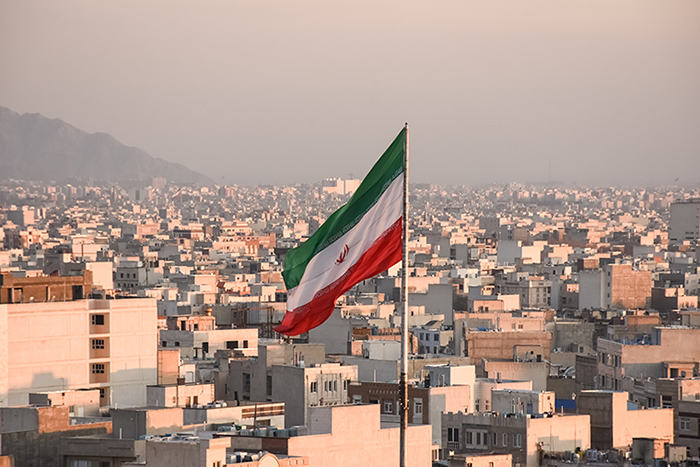Interviews / Middle East / North Africa
7 November 2024
War with Israel, Trump’s Election, and Internal Protests: Is Iran Cornered?

The historical regional rivalry between Tehran and Tel Aviv intensified following the October 7, 2023, attacks, eventually escalating into direct conflict in 2024. The United States’ role in this confrontation also appears likely to expand, particularly with the election of Donald Trump, who during his first term demonstrated unwavering support for Israel through the Abraham Accords and the recognition of Jerusalem as its capital, alongside significant hostility toward Iran, including the withdrawal from the nuclear deal and the assassination of Qassem Soleimani.
In parallel with this external destabilisation, Iran continues to face internal dissent, exemplified by the protest of a student who removed her hijab to oppose the mandatory veiling law. How is the conflict between Tehran and Tel Aviv evolving? What impact might Trump’s re-election have on the region? How do protests by the Iranian population, especially women, continue to manifest? These questions are analysed by Julia Tomasso, a junior researcher with the Defence and Security Industry Programme at IRIS.
Israel bombed several military sites in Iran on October 26, 2024. What is the current state of the conflict between Israel and Iran?
For several months, Israel and Iran have been engaged in a large-scale direct confrontation, marked by strategic escalations and successive military retaliations. The Israeli bombing on October 26, 2024, targeted around twenty strategic military sites in Tehran, Khuzestan (southwest), and Ilam (west). So far, Iran’s response has not materialised. However, in line with his stance, Supreme Leader Ayatollah Ali Khamenei declared that Iran would not “leave any enemy action unanswered.” It is unlikely that Iran will extend its strikes to northern Israel, near the Lebanese border, where Israel remains militarily mobilised. Tehran appears intent on separating its broader deterrent role from the Lebanese issue, which is tied to Hezbollah. By avoiding direct conflict in this area, the Iranian government aims to preserve its deterrence credibility without jeopardising the stability of its regime.
The growing scale of Iran’s retaliatory measures is worth noting. Over the past four years, these have increased in both volume and precision. For example, the Iranian strike on October 1, 2024, involved 180 ballistic missiles compared to 120 in April 2024 and 80 in January 2020. Tehran is thus intensifying its ballistic missile strikes, asserting its power and reminding the region of its retaliatory capabilities.
On the diplomatic front, this attack has provoked strong reactions across the Arab world. Egypt and Qatar’s condemnation of the Israeli assault reflects a significant shift: historical regional allies of the United States and Israel are now expressing reservations about Israeli actions. Over the past two years, the region’s geopolitics have undergone profound changes. Traditional alliances of a pro-Iranian bloc against an anti-Iranian bloc are gradually dissolving. As a result, the Near and Middle East appears to be moving towards a strategy of multi-alignment. States are maintaining parallel relations with various powers, seeking to maximise their interests by diversifying partnerships.
The U.S. military, for its part, deployed several bombers to the Gulf region on November 4. What impact could the reinforcement of American forces in the region have on this confrontation? With Donald Trump recently re-elected as President of the United States, what consequences might his policies have on the relationship between Washington and Tehran?
The reinforcement of the U.S. military presence in the region adds latent pressure to the conflict between Tehran and Tel Aviv. For the United States, the recent deployment of bombers and warships serves three major objectives: deterring any Iranian attacks, supporting Israel against potential threats from Iran, and reducing the risk of aggression against American and allied interests. By bolstering its deterrence capabilities, Washington aims not only to protect its regional interests but also to send a clear message to Iran and its allies. Currently, nearly 40,000 U.S. troops are stationed across American bases in the Middle East, including Al Udeid Air Base in Qatar—the largest U.S. military base in the region—as well as in Bahrain, Kuwait, Saudi Arabia, and the United Arab Emirates (UAE). However, increased U.S. involvement could exacerbate tensions with Iran and, by extension, deepen geopolitical divides between U.S.-aligned Arab countries and those leaning towards rapprochement with Iran.
In this context, the now-official re-election of Donald Trump could further harden U.S. policy in the Near and Middle East, potentially leading to a prolonged diplomatic rift with Tehran. While the new Iranian president, Masoud Pezeshkian, prioritises reopening nuclear negotiations, Donald Trump is inclined to maintain intense military and economic pressure on Iran.
Amid these regional tensions, on the domestic front, images of an Iranian student being arrested by police after removing her clothes in protest against the mandatory wearing of the hijab and covering garments have circulated widely in global media. What is the current state of these protests two years after the “Woman, Life, Freedom” movement demonstrations? To what extent does opposition to the Islamic Republic regime persist within Iranian society?
Two years after the protests sparked by the death of Mahsa Jina Amini in September 2022, the “Woman, Life, Freedom” movement marked a turning point in the history of dissent against the Islamic Republic regime. However, the brutal repression by Iranian authorities seems to have stifled large-scale demonstrations. The Iranian regime has established powerful policing and legislative tools to suppress any form of protest by women and ethnic minorities.
Since April 2024, a new nationwide campaign, called the “Noor Plan,” has been implemented to intensify the enforcement of mandatory hijab laws. This campaign has led to a significant increase in security patrols in public spaces. On September 18, 2024, a major legal development further reinforced existing hijab legislation. The Guardian Council approved the “Law on Family Protection through the Promotion of the Culture of Hijab and Chastity.” This law imposes severe penalties on women and institutions that fail to comply with hijab requirements, including longer prison sentences, fines, and restrictions on access to education and employment. Its adoption has heightened pressure on Iranian women while institutionalising repression.
Despite this increased crackdown, dissent persists. Iranians, particularly women, continue to resist through various means, including discreet protests, social media activism, and acts of defiance, such as those by Ahoo Daryaei. The evolution of Iranian society demonstrates that a silent yet resilient resistance endures in both private and public spheres, despite systematic repression.

